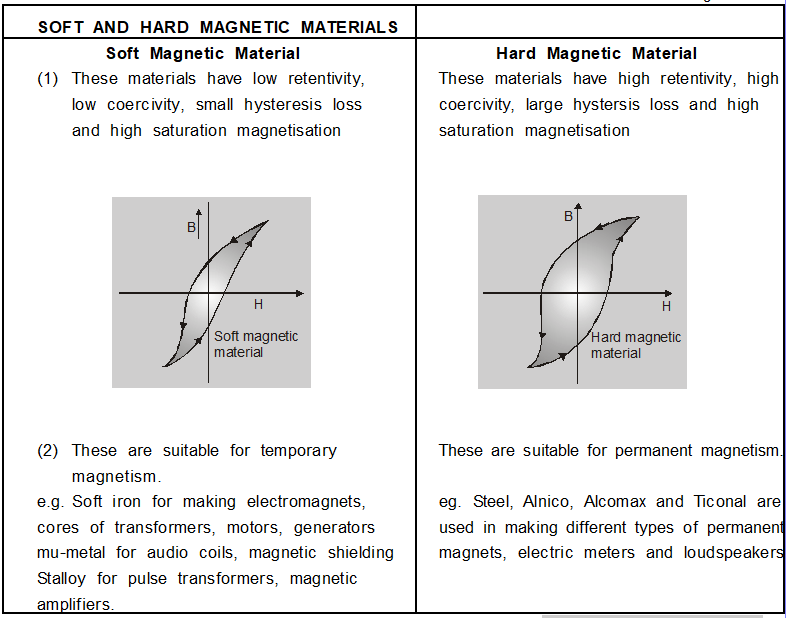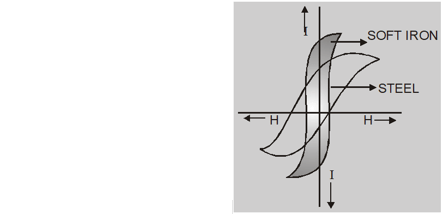Hard magnetic materials are difficult to magnetize and demagnetize, such as tungsten steel, ferrite, neodymium-iron-boron, etc. These materials are easy to magnetize and difficult to demagnetize. They are mainly used as tape materials and permanent magnets. Soft magnetic materials refer to ferromagnetic materials with narrow hysteresis loops, high permeability, low remanence, low coercivity and low magneto resistance. Difference Between Soft and Hard Magnetic Materials are as Follows:

 5.Soft iron acquires saturation magnetisation for quite low value of magnetising field than in case of steel or soft iron is much strongly magnetised than steel.
5.Soft iron acquires saturation magnetisation for quite low value of magnetising field than in case of steel or soft iron is much strongly magnetised than steel.
Ex. An iron sample of mass 8.4 kg is repeatedly magnetised and demagnetised at a frequency of 50 cycles/sec. $3.2 \times 10^{4}$ Joule of energy is lost as heat in 30 minutes. If density of iron is 7200 $\mathrm{kg} / \mathrm{m}^{3}$ calculate the value of energy dissipated per unit volume per cycle in iron sample. Sol. If H is energy lost per unit volume per second in iron sample then energy lost by sample in a given time t is $E=H V n t$ where V is volume of sample So $\quad \mathrm{H}=\frac{\mathrm{E}}{\mathrm{Vnt}}=\frac{3.2 \times 10^{4} \times 7200}{8.4 \times 50 \times 30 \times 60}=304.8 \mathrm{Jm}^{-3} \mathrm{cycle}^{-1}$ dia, para and ferromagnetic substances

Comparison of properties of Soft iron and Steel
- The area of hysteresis loop for soft iron is much smaller than for steel so energy loss per unit volume per cycle or soft iron is smaller than steel.
- The retentivity of soft iron is greater than that of steel.
- The coercivity of steel is much larger than that of soft iron.
- The magnetisation and demagnetisation is easier in soft iron than steel.
 5.Soft iron acquires saturation magnetisation for quite low value of magnetising field than in case of steel or soft iron is much strongly magnetised than steel.
5.Soft iron acquires saturation magnetisation for quite low value of magnetising field than in case of steel or soft iron is much strongly magnetised than steel.
Ex. An iron sample of mass 8.4 kg is repeatedly magnetised and demagnetised at a frequency of 50 cycles/sec. $3.2 \times 10^{4}$ Joule of energy is lost as heat in 30 minutes. If density of iron is 7200 $\mathrm{kg} / \mathrm{m}^{3}$ calculate the value of energy dissipated per unit volume per cycle in iron sample. Sol. If H is energy lost per unit volume per second in iron sample then energy lost by sample in a given time t is $E=H V n t$ where V is volume of sample So $\quad \mathrm{H}=\frac{\mathrm{E}}{\mathrm{Vnt}}=\frac{3.2 \times 10^{4} \times 7200}{8.4 \times 50 \times 30 \times 60}=304.8 \mathrm{Jm}^{-3} \mathrm{cycle}^{-1}$ dia, para and ferromagnetic substances
About eSaral At eSaral we are offering a complete platform for IIT-JEE & NEET preparation. The main mission behind eSaral is to provide education to each and every student in India by eliminating the Geographic and Economic factors, as a nation’s progress and development depends on the availability of quality education to each and every one. With the blend of education & technology, eSaral team made the learning personalized & adaptive for everyone.For free video lectures and complete study material, Download eSaral APP.
